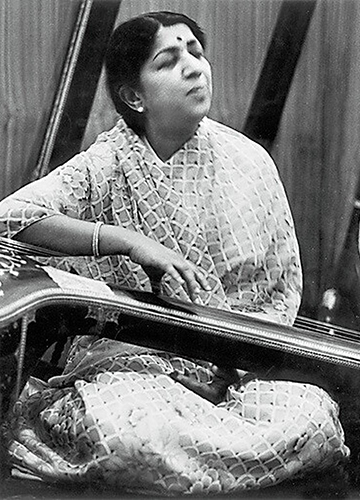IN AN EARLIER interview with this writer, classical maestro Pandit Jasraj had compared a singer’s timbre to his or her signature. It is a special feature that sets it apart, besides determining the choice of songs. In the case of Lata Mangeshkar, it was her timbre that instantly attracted many of her fans.
Yet, there was more to Lata than the sheer quality of her voice. Many factors contributed to her legendary status. The training that went into honing that voice, her quest for perfection, her technique, her diction, the minor flourishes, her ability to complement the heroine’s screen persona and her discretion made her stand out. In many senses, Lata was Lata.
Take her hit “Aaja re pardesi” from the 1958 film Madhumati. On paper, it was a wonderful composition by Salil Chowdhury in raag Bageshri, with writer Shailendra talking about a girl waiting. But listen to the way Lata sings the word ‘re’ each time “Aaja re” appears. The minor changes are like a masterclass. In the same film, she also sang “Ghadi ghadi mera dil dhadke” in Bageshri, suddenly pausing after the word ‘sarke’ to make it special.
Also from 1958 is Madan Mohan’s “Unko yeh shikayat”, composed in raag Malgunji in the film Adalat. Picturised on Nargis, the song was written by Rajendra Krishan in a ghazal format, with “Kuchh nahin kehte” ending each couplet. Most of the time, Lata sings those words in a similar manner, but the discerning ear will notice the minor fluctuation at the end of the mukhda (starting lines) and the major variant at the end. Her Urdu diction is perfect on words like zubaan, inaayat and qayaamat.
Over the years, listeners have had different ways of appreciating Hindi film songs. A majority of them would soak in the basic melody, humming along with the composition. Some would get deeper into the lyrics, sometimes memorising them. Still others would keenly note the finer nuances. Now, while this type of listening happens with all singers, there was something distinct in the way Lata approached the third quality.
Examples abound, but this individuality would come only with her desire for perfection. Before she hit the big time in 1949 with Shankar-Jaikishan’s songs from Barsaat and the outstanding “Aayega aanewala” in Mahal, naysayers had two complaints. One was that her voice was too thin, and the other was that she tended to display a Marathi touch in her accent.
She worked on the latter by taking Urdu lessons from a teacher named Shafi—a wonderful example of her mastery being her rendition of classical poet Mir Taqi Mir’s “Dikhayi diye yoon”, composed by Khayyam in the 1982 film Bazaar. Check her presentation of the words ‘haq-e-bandagi’ and ‘parastish ki yaan tak ki ai but tujhe’. Combined with perfect thehraav, or sustenance of notes, and an ability to glide over registers, she created magic in many of her songs.
As for her voice quality, she tweaked her style as per the actor she represented. On screen, “Mohe bhool gaye saawariya” from Baiju Bawra (1952) looked like Meena Kumari was singing it. “Tera jaana” seemed like the voice of Nutan in Anari (1959) and “O basanti pawan paagal” synchronised perfectly with Vyjayanthimala in Jis Desh Mein Ganga Behti Hai (1960).
Two of Lata’s biggest hits—”Chand phir nikla” by S.D. Burman in Paying Guest (1957) and “Rasik balma” by Shankar-Jaikishan in Chori Chori (1956)—were composed in the same raag, Shuddha Kalyan, with a similar opening. Yet, the singer made it sound like ”Chand phir nikla” was made only for Nutan, and “Rasik balma” only for Nargis.
So far, we have focused on Lata’s broader singing qualities. There were, of course, other factors that contributed to the Lata Mangeshkar phenomenon. One was the timing of her rise. By 1949, the year of her big break, Noor Jehan had settled in Pakistan. Amirbai Karnataki had switched to acting, and Zohrabai Ambalewali had reduced work. In the early 1950s, Lata’s main competitors were Suraiya, Geeta Dutt and Shamshad Begum, with Asha Bhosle getting many offers, but missing the big hits. While Geeta Dutt had many memorable songs, the others sang specific types of tunes.
In such a scenario, and given her ever-increasing hit rate, top music directors preferred Lata. While Shankar-Jaikishan and Naushad consistently gave her great songs, she had “Thandi hawayein” with S.D. Burman in Naujawan (1951), and “Yeh zindagi usi ki hai” and “Mohabbat aisi dhadkan hai” with C. Ramchandra in Anarkali (1953). Later, Madan Mohan, Salil Chowdhury, Hemant Kumar, Roshan, Kalyanji-Anandji and Laxmikant-Pyarelal were to continue, whereas R.D. Burman maintained a good balance between her and Asha. Only O.P. Nayyar did not work with her.
Besides solo songs, Lata had memorable duets with Mohammed Rafi, Mukesh, Kishore Kumar, Manna Dey and Talat Mahmood, and later with S.P. Balasubrahmanyam. In Hindi film music, coordination and timing also determine a singer’s mastery over duets. In Lata’s case, her songs with Manna Dey—“Pyaar hua ikraar hua” in Shree 420 and “Aaja sanam” in Chori Chori (1956)—are prime examples of her brilliance. And who can forget the songs she sang with Kishore for R.D. Burman in the 1975 film Aandhi—“Tere bina zindagi se”, “Is mod se jaate ho” and “Tum aa gaye ho”?
One can never tire of listening to Lata’s classics. Even 50 or 60 years after their release, they sound fresh. And this is not only with the film songs, as one gets gooseflesh listening to her patriotic song “Ae mere watan ke logon”, her bhajan “Paayoji maine” or her numerous regional language tunes. She has given us special moments, like the way she improvised on the line “Yeh chiragh bujh rahe hain” in Ghulam Mohammed’s song “Chalte Chalte” in Pakeezah (1972), or that immortal ‘Alvida alvida’ climax in “Yeh zindagi usi ki hai”. Such sparks can never diminish, there is no saying goodbye to such gems, ever.



